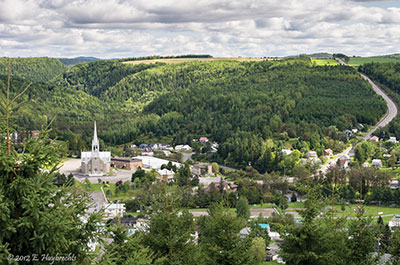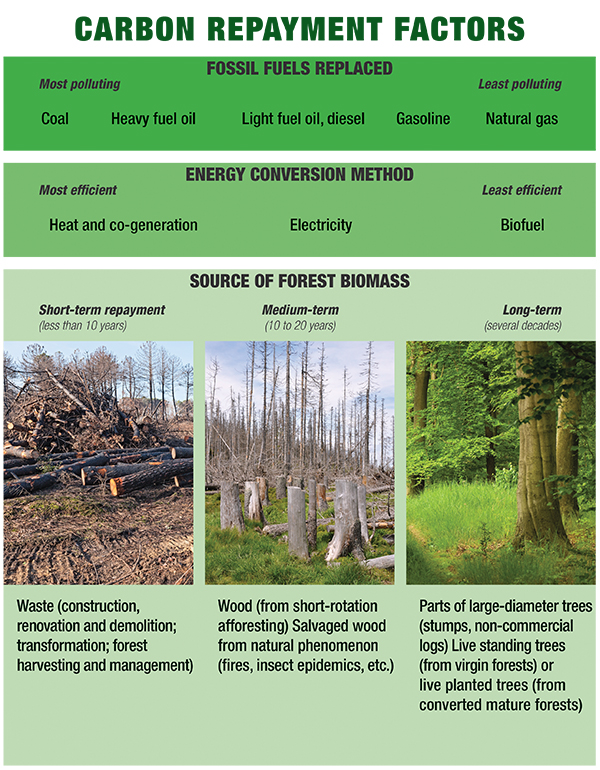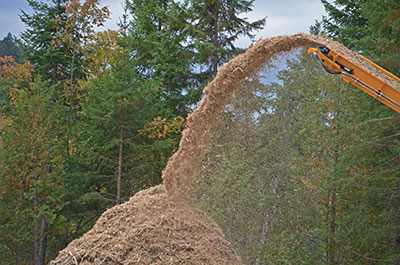
Paying off Carbon Debt
August 7, 2013
By Amélie St-Laurent Samuel
Much has been said about the benefits of using forest biomass energy as an alternative to fossil fuels.
Much has been said about the benefits of using forest biomass energy as an alternative to fossil fuels. There is no shortage of arguments in support of the new energy sectors forming around this resource: job creation and growth, economic diversification of communities, independence from oil, mitigation of climate change, and lower costs for users. However, several stakeholders are now raising questions about the impacts of biomass energy and about our actual capacity to achieve all of its benefits.
 |
|
Based on the notion that all energy sources have an inevitable impact on the natural environment where they are deployed, processes must systematically be put in place to ensure projects are executed in the most harmonious and sustainable way possible. Research, especially that provided by field studies, helps document their impacts and define best practices likely to reduce or eliminate them. But if this research is to be useful, those involved closely with the projects must embrace and implement these environmental frameworks.
In Quebec, the forest biomass heating sector is still in its infancy. A multitude of stakeholders – equipment manufacturers, consultants, raw materials suppliers, economic development organizations, researchers, environmentalists, etc. – are still working to solidify its foundations. This burgeoning sector has thus developed into a complex web involving several different players, a reality that can cause confusion for municipalities and organizations who hope to invest in forest biomass-based heat production projects. Furthermore, in the absence of an official advocate, environmental issues run the risk of falling through the cracks. In this context, one question remains unanswered: how can we give proper emphasis to these challenges?
The winning conditions
The actual impact of forest biomass energy as a means to mitigate climate change is still a hot topic in the public arena. And yet, the scientific community generally agrees on the “winning conditions” that must be in place in order to ensure that forest bioenergy is produced in a way that maximizes the reduction of greenhouse gas (GHG) emissions.
You may not be aware that forest biomass combustion produces more CO2 emissions per energy unit than fossil fuels. For this reason, biomass energy production results in an initial surplus of GHG emissions, a “carbon debt,” when compared with conventional fuels. Fortunately, the biological processes involved in the carbon cycle contribute to repaying this temporary debt. The carbon cycle of fossil fuels, which extends over millions of years, is much longer than the cycle of biomass. Since biomass relies on the natural growth and decomposition of trees, its cycle extends over a few decades only. With time, carbon sequestration by trees compensates for additional emissions related to the use of biomass and generates permanent, cumulative environmental benefits.
So why worry about this “carbon debt”? It is important to stress that CO2, as soon as it is released in the atmosphere, has appreciable effects on climate. In turn, climate impacts natural habitats, population health and well-being, infrastructures, and economic activities – on multiple levels. Consequently, a long repayment period can make it harder to achieve short- and medium-term emission targets set by the different levels of government.
We must therefore favour a quick repayment of this “carbon debt.” This relies on three main factors, namely: 1) the energy conversion method used; 2) the type of fossil fuel replaced by biomass; and 3) the source of forest biomass.
 |
A project and its challenges
Beyond each of the “winning conditions,” it is by combining them within a concrete project that we can fulfil the potential of biomass as a tool to mitigate climate change. Therefore, all aspects must be considered during the planning process. The challenge we face is to make knowledge and technical means available and accessible, and to encourage communication between the various stakeholders.
 |
|
| Forest-based biomass provides a better life-cycle fuel solution than using fossil fuels.
|
The key is to develop and distribute knowledge transfer tools. First, biomass project managers and users have to be aware of the consequences that their procurement decisions have on climate. They must be able to demand factors of production that reflect their objectives (sources associated with a small carbon debt), while operating within their budget. Furthermore, biomass suppliers must be able to meet their clients’ demands (quantity and quality of resources), at an acceptable cost of production. To do this, they must notably be able to rely on more efficient harvesting, processing and transport processes, as well as stable demand. As the sector gains traction, loggers can achieve new means of supplying biomass with characteristics that meet the climate challenge, in keeping with the support capacity of ecosystems.
Effective communication between each link of the supply chain is also key. Indeed, if they are to integrate each of the “winning conditions” at the root of their project planning, biomass users must clearly express their commitment to mitigating climate change. For example, by further integrating the various steps of the transportation process, notably by examining the moisture level of the biomass to be transported or by planning a temporary storage facility, needs can be decreased in a way that reduces GHG emissions. Efforts must also be made to communicate with the public in order to gain support for projects that truly contribute to mitigating climate change. This reality highlights the importance for biomass users of surrounding themselves with professionals who won’t hesitate to present them with a variety of options in order to adequately meet their needs and their goals, economically, socially and environmentally. These professionals will also keep them from working in silos.
Seizing the opportunity
This type of reflection applies to all the sustainable development challenges faced by the biomass energy production sector. For example, health-related air quality management and biodiversity protection both rely on identifying best practices based on science. These best practices must be applied to each project. Of course, this requires additional efforts in the planning and communication stage. We must nevertheless seize the benefits offered by biomass as an alternative to fossil fuels: the opportunity to build projects that differentiate themselves with a small ecological footprint and that truly benefit communities.
Amélie St-Laurent Samuel is a forest/biomass project manager at Nature Québec (amelie.st-laurent-samuel@naturequebec.org), where she is responsible for the “Biomasse forestiére et climat : communautés en action” project. This project, financed in part par the Fonds d’action québécois pour le développement durable, provides a free support service to organizations who wish to convert their fossil fuel heating systems to forest biomass-based systems.
Print this page